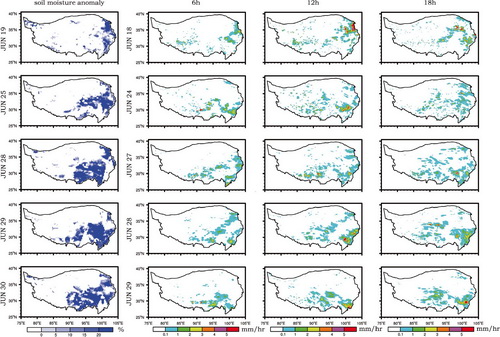The Tibetan Plateau (TP), which is the highest and largest highland in the world, has profound influences on not only the local climate but also the climate of the Asian continent, even on the global climate. In addition, with extensive glaciers and permafrost, the TP is also the source of many rivers in Asian, which is called as the “Asian Water Tower”. Therefore, it is obvious that the hydrological research on the TP has important significance under the background of the global warming.
Recently, a research group led by Prof. MENG Xianhong from the Key Laboratory of Land Surface Process and Climate Change in Cold and Arid Regions, Northwest Institute of Eco-Environment and Resources (NIEER) of Chinese Academy of Sciences has detected the hydrological consistency between soil moisture and precipitation and changes of soil moisture in summer over the Tibetan Plateau using the European Space Agency (ESA) soil moisture product and the observational meteorological dataset.
The ESA soil moisture product is the first purely multi-decadal satellite-based soil moisture product that was designed for climate applications, and it was used to study the response of surface soil moisture to climate change on the TP from November 1978 to December 2013.
The research results show that there is significant correlation between the ESA soil moisture product and the observed precipitation. The positive anomaly of the ESA soil moisture product can well reflect the occurrences of precipitation, but precipitation may not definitely lead to soil moisture anomaly, which largely depends on the precipitation amounts.
With the global warming, the warming on the TP is more rapidly and larger than its surrounding regions, showing that the TP is also an indicator and amplifier of the global warming. Under the rapid warming circumstances, most regions of the TP have been experiencing wetting in the last three decades. The accelerated climate change on the TP has caused many environmental changes, such as permafrost degradation, glacier retreat and snow melt etc. As a result, significant changes in hydrology and water resources occurred on the TP.
As one of the important hydrological factors, soil moisture responses to climate change quickly and interacts with the overlaying atmosphere through surface energy and water balance, substantially leading to a feedback to regional climate. It is also a key variable in numerous environmental applications, including the hydrological modelling, weather and short-term climate forecasting. Besides, changes of soil moisture on the TP can influence the sensible heating of the TP, resulting in formation and variations to Asian monsoon, influencing the climate change in Asian.
This research is financially supported by the Chinese National Science Foundation Programs (91437102; 41375015, 91537214 and 41675157), the CAREERI STS Funding (Y651671001), the Chinese Academy of Youth Innovation and Promotion, CAS (2014384) and the China Special Fund for Meteorological Research in the Public Interest (GYHY201506001-04). The soil moisture product and the observational datasets have been provided by the European Space Agency (ESA) and the China Meteorological Administration (CAM).
This research achievement has been published on Climate Dynamics.
Contact:
MENG Xianhong
E-mail: mxh@lzb.ac.cn
Key Laboratory of Land Surface Process and Climate Change in Cold and Arid Regions, Northwest Institute of Eco-Environment and Resources, Chinese Academy of Sciences, Lanzhou, 730000, P. R. China.

Fig. Comparison of the ESA soil moisture anomaly for identified rain days during June 2009 over the TP. The observed hourly rainfall amounts (instantaneous rain-rate) are shown for 6, 12 and 18 h preceding the ESA overpass time (08 a.m. BT). Soil moisture anomaly is the difference between daily values and the monthly average, only showing a positive (wet) anomaly (Image by MENG Xianhong) Fig. Comparison of the ESA soil moisture anomaly for identified rain days during June 2009 over the TP. The observed hourly rainfall amounts (instantaneous rain-rate) are shown for 6, 12 and 18 h preceding the ESA overpass time (08 a.m. BT). Soil moisture anomaly is the difference between daily values and the monthly average, only showing a positive (wet) anomaly (Image by MENG Xianhong)

